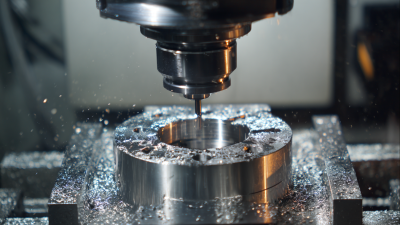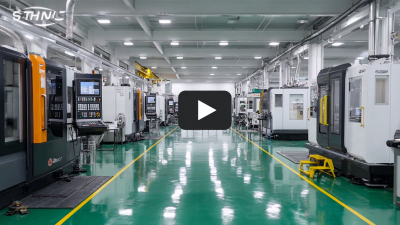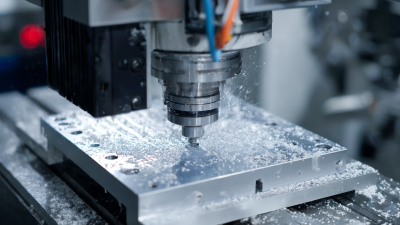Blog
Unlocking the Secrets of 5 Axis CNC Mill for Precision Engineering Success
In the evolving landscape of precision engineering, the adoption of advanced manufacturing technologies continues to shape industry standards. Among these innovations, the 5 axis CNC mill stands out as a game-changer, enabling intricate designs and unparalleled precision. According to a recent report by MarketsandMarkets, the 5 axis CNC machine market is projected to reach $4.35 billion by 2025, demonstrating significant growth fueled by the increasing demand for high-precision components across sectors such as aerospace, automotive, and healthcare.

Industry expert Dr. Emily Chen, a leading figure in CNC technology research, emphasizes the critical role of 5 axis CNC mills in solving complex manufacturing challenges. She states, "The capability of a 5 axis CNC mill to simultaneously manipulate cutting tools from multiple angles allows manufacturers to produce parts that were previously deemed impossible." This sentiment reflects the growing recognition of the 5 axis CNC mill's strategic importance in enhancing operational efficiency and maintaining competitive advantage in today's precision engineering environment.
As we delve deeper into the secrets of this remarkable technology, we uncover the factors contributing to its success and explore best practices that ensure optimal performance in various applications.
Understanding the Basics of 5 Axis CNC Milling for Precision Engineering
5 Axis CNC milling represents a significant advancement in the realm of precision engineering, allowing for intricate designs and complex geometries to be crafted with remarkable accuracy.
This technology enables the cutting tool to move across five different axes simultaneously, providing the capability to create detailed components that were previously challenging or impossible to achieve with traditional three-axis milling machines.
Understanding the basics of this process is essential for engineers seeking to enhance their manufacturing capabilities.
At its core, 5 Axis CNC milling involves two rotary axes and three linear axes.
This configuration allows for the tool to approach the workpiece from various angles, ensuring the machining of hard-to-reach areas without the need for repositioning the part.
As a result, engineers can achieve tighter tolerances, reduce production time, and minimize the number of fixtures required.
By mastering the principles of 5 Axis CNC milling, precision engineering professionals can unlock new possibilities for innovation and efficiency in their projects, ultimately leading to superior product outcomes.
Key Advantages of 5 Axis CNC Mills Over Traditional Machining Techniques
The advent of 5 Axis CNC mills has revolutionized the landscape of precision engineering, providing significant advantages over traditional machining techniques. With their ability to manipulate the cutting tool across five different axes simultaneously, these machines allow for more complex geometries and intricate designs that are often difficult or impossible to achieve with conventional methods. This capability leads to enhanced precision, as the workpiece can be approached from multiple angles without the need for repositioning, ultimately reducing part errors and increasing dimensional accuracy.
Moreover, 5 Axis CNC mills offer considerable improvements in efficiency. Traditional machining typically requires multiple setups and tool changes, which can be time-consuming and prone to inaccuracies. In contrast, a 5 Axis mill can complete an entire project in one continuous process, significantly shortening lead times and minimizing labor costs. Additionally, the ability to machine more sides of a component in a single setup reduces the risk of misalignment and the associated scrap costs. This streamlined approach not only enhances productivity but also fosters innovation, allowing engineers to tackle more ambitious designs with confidence.
Essential Features to Look for in a High-Quality 5 Axis CNC Machine
When exploring the world of 5 Axis CNC machines, understanding the essential features becomes paramount for achieving precision engineering success. With the manufacturing industry significantly transformed by digitalization, automation, and advancements in AI and IoT, selecting the right CNC machine is crucial. High-quality 5 Axis CNC mills should prioritize features such as high-speed machining capabilities, which enhance surface finishes and efficiency. Look for machines equipped with optimized settings that allow for seamless operation on free-form surfaces.
Tips for choosing the right 5 Axis CNC machine include examining the machine's automation level and its compatibility with emerging technologies. Furthermore, consider the CNC machine's ability to handle complex geometries, allowing engineers to produce intricate designs with ease. High-precision components, effective coolant systems, and robust software integration will ensure that your CNC machining meets the demands of modern manufacturing.
Moreover, take note of market trends indicating a projected growth in the CNC machine sector. A strong focus on features like advanced displays, user-friendly interfaces, and integrated data analytics tools can facilitate better management and optimization of machining processes. As the industry leans towards smarter solutions, investing in a high-quality 5 Axis CNC mill will set the foundation for successful engineering outcomes.
Tips for Setting Up and Optimizing Your 5 Axis CNC Milling Process
Setting up and optimizing a 5-axis CNC milling process is crucial for achieving precision in engineering projects. A key component in this optimization is the use of post processors. These are software modules that convert the toolpath data generated in CAD/CAM programs into machine-readable code. Understanding their function is essential as they enable complex movements produced by 5-axis machines, ensuring that the commands executed by the CNC mill align perfectly with the intended design specifications. This not only improves machining accuracy but also enhances the overall efficiency of the milling process.
In addition to post processors, other strategies for optimizing 5-axis CNC operations include fine-tuning milling parameters through NC machining technology. Systematic research and experimental setups can reveal the perfect settings for feed rates, spindle speeds, and cutting depths, tailored to specific materials and part designs. The advancements in simulation software also play a pivotal role, allowing for high-speed toolpath planning and better accuracy, while digital twin capabilities help in anticipating and resolving potential issues before they arise in the manufacturing process. These innovations collectively pave the way for the next generation of 5-axis CNC technology, elevating the manufacturing landscape to new heights.
Unlocking the Secrets of 5 Axis CNC Mill for Precision Engineering Success
| Aspect | Description | Optimal Setting/Value | Impact on Precision |
|---|---|---|---|
| Tool Selection | Choosing the right cutting tool for the material. | High-speed steel or carbide tools | Directly affects surface finish and material removal rate. |
| Spindle Speed | Optimal rotations per minute (RPM) for cutting. | 6000-12000 RPM | Enhances accuracy and reduces risk of tool wear. |
| Feed Rate | Speed at which the tool advances through the material. | 200-500 mm/min | Balancing speed to ensure precision versus efficiency. |
| Cooling/Lubrication | Use of coolants to reduce heat and friction. | Water-soluble or oil-based coolants | Improves tool lifespan and part quality. |
| Workpiece Setup | Secure mounting of materials to ensure stability. | Use of fixtures and clamps | Prevents movement for precise cuts. |
Common Challenges and Solutions in 5 Axis CNC Milling Operations
In the realm of precision engineering, 5-axis CNC milling has emerged as a fundamental technology, overcoming many operational challenges. One of the most pressing issues faced by engineers in this field is the complexity of post processors. Post processors are crucial in converting the CAD/CAM outputs into machine-specific code, enabling seamless operation across different CNC machines. As the market for 5-axis CNC machining centers is projected to grow by USD 792.5 million from 2024 to 2028, driven by advancements in self-optimized machine cutting and the increasing integration of AI technologies, understanding how to effectively utilize post processors in software like Fusion becomes paramount.
Tip: Ensure that your post processor is adequately tailored for your specific machine model. This customization can significantly reduce errors and improve machining efficiency, allowing operators to maximize the capabilities of their 5-axis CNC mill. Moreover, staying updated on AI trends within the industry can lead to better decision-making when it comes to investment in new technologies or machine tools.
Another common challenge in 5-axis milling operations is managing the intricate workflows required for setup and programming. With the right software tools and training, however, these challenges can be mitigated. Leveraging intuitive interfaces and simulation capabilities within your CAM software can streamline the programming process, ultimately leading to decreased setup times and increased precision in machining.
Tip: Invest time in exploring the simulation features in your CAM software. Simulating the machining process can highlight potential issues before physical machining begins, saving both time and material costs, while ensuring a higher quality end product.
Related Posts
-

Trusted Quality: Discover the Best 5 Axis CNC Mill from China for Global Excellence
-

Transform Your Workshop with High Precision CNC Lathe Technology
-

Exploring the Advancements in Milling Machine Technology for Modern Manufacturing
-

Transforming CNC Milling Machine Market Dynamics at China Import and Export Fair 2025
-

Understanding the Importance of Best CNC Manufacturing in Global Supply Chains
-

Master Your Craft with the Ultimate Guide to the Best Small CNC Machine for Your Business